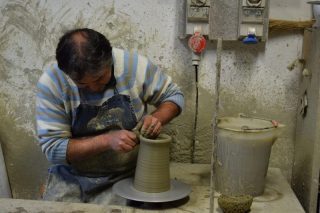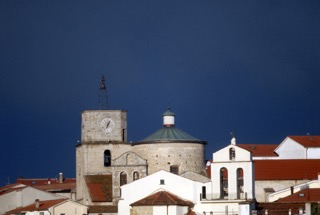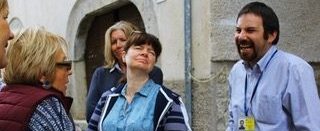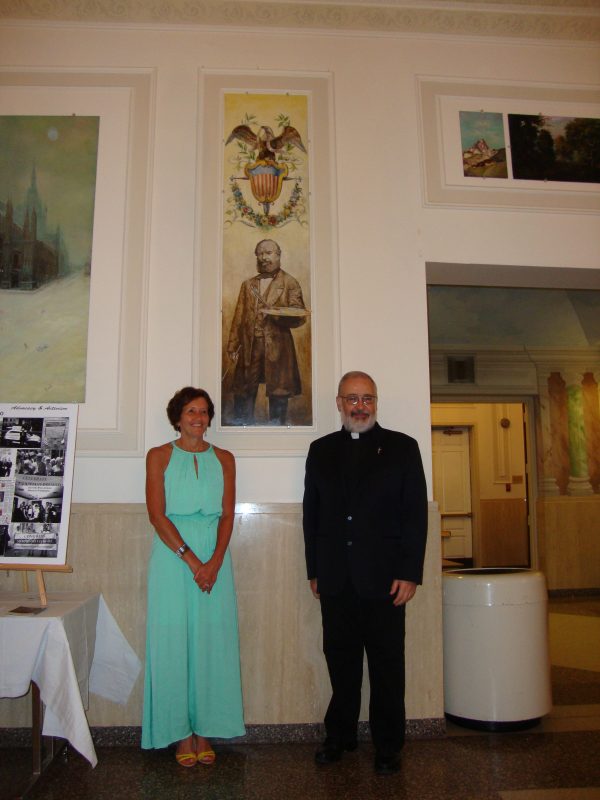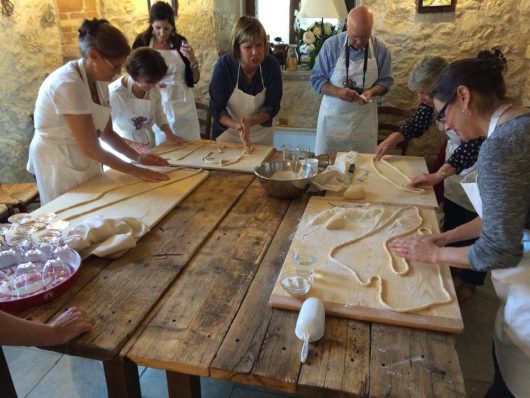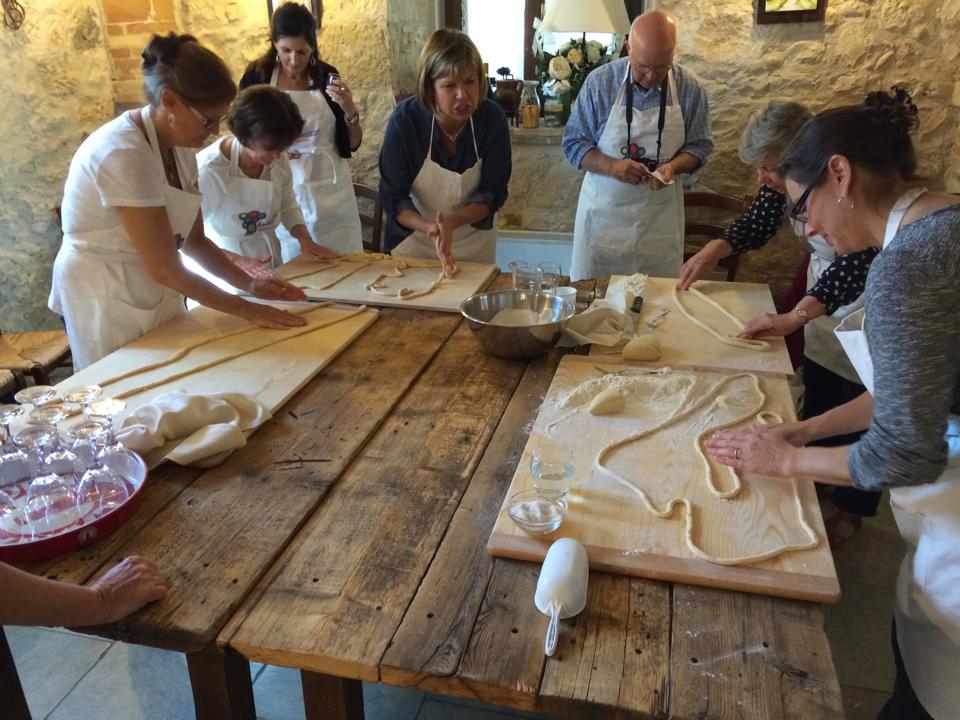-
Discovering Renaissance Ceramics in Abruzzo
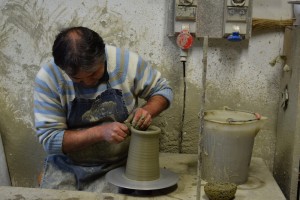
Written by Carma Fountleroy with photographs courtesy of Nancy Coviello.
In October, Maestro Roberto Paolinelli arranged for his ceramic students from Casa Italiana Language School in Washington DC, to experience the best field trip imaginable.
For more than a decade, Maestro Roberto has been teaching Italian Renaissance Castelli-style ceramic painting at Casa Italiana. For a million different reasons, before 2015 it was not possible for Maestro Roberto to accompany a student group to Italy. This year he agreed to accompany students to his hometown Pescara, Italy, where he was a professional artist and gallerist until his retirement to Northern Virginia. Roberto, along with his brother, artist Albano Paolinelli, guided students to ceramics museums and artists workshops throughout the Pescara and Chieti provinces of Abruzzo. (You can learn more about the art of Albano at: http://www.albanopaolinelli.it/)
The visits to the four ceramic collections were one of the main highlights of the trip, not just the collections themselves but the enthusiastic and knowledgeable curators. As it turned out, each museum opened specially for our group. This was due to scheduling as three of the museums are in very small towns and usually only open on Saturday and Sunday. Since we needed to visit on Thursday or Friday, they made an exception. The welcome at each of these places could not have been warmer or more enthusiastic.
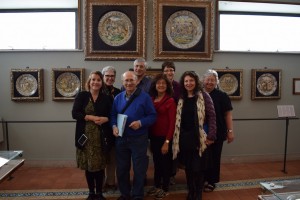
We started with the Acerbo Museum in Loreto Apurtino. The displays were breath-taking examples of the work of Francisco Grue, considered by many to be the all-time master of Castelli-style of painting. Next we visited another ceramic center, the village of Rapino. There we were met at the museum by a resident and enthusiastic guide, Antonella. This museum also has a school which offers ceramic workshops throughout the year. Our next museum stop was in Castelli where the collection holds not only wonderful examples of traditional Castelli ceramics, but also some of the original ceiling tiles from the Church of San Donato. Our final museum visit was to the Paparella Treccia-Devlet Museum in Pescara which was closed due to a change in special exhibitions. The museum agreed to open specially on Saturday morning for our group to visit. It is housed is a lovely preserved Palazzo in downtown Pescara and has a wide-ranging collection of Castelli ceramics.
Another highlight was the visit to the ceramic studios of working artists. While visiting both Castelli and Rapino it was obvious due to empty shops that such studios are in decline, yet the ones we visited had extremely talented working artists. Highlights included Antonio Di Simone in Castelli and Giovannina Tosca in Rapino. Giovanna’s Facebook page has lots of images of her work.
Bittersweet was the recognition that hand-painted ceramics was the economic staple of small Italian towns for centuries but now the traditional artisans and workshops are slowly disappearing. With the declining post-recession market for such goods, modern industrial aesthetics and the departure of young adult populations for training and jobs in urban areas, we realized how precious and fleeting a moment in time we experienced and treasured.
When we visited Rapino and Castelli we seemed to be the main attraction in town as on a Fall weekday there were few other tourists. The nice part about standing out in this fashion was how curious, friendly and helpful everyone was to us. We could not have received a nicer welcome. Many visitors to Italy are amazed and perhaps disappointed that many people speak English. Refreshingly, this is not the case in Abruzzo’s Adriatic coast or in Pescara where Italians spend seaside holidays. How refreshing to spend a week where English wasn’t spoken ubiquitously. At one highly recommended seafood restaurant, the 20s-something staff brought out their tablets to provide Google translations of their fresh daily menu.
There were many wonderful moments, so it is hard to select just one. One fond memory is that of the visit to the Castelli Bottega or Studio of Antonio Di Simone who has spent a lifetime practicing and mastering Castelli ceramics. During our tour of his workshop, he showed us ceramic molds from his grandfather’s time dated in the 1870s. Also the visit to the Church of San Donato in Castelli was memorable. Another would be the meal we shared in the home of Albano and Gabriella Paolinelli where we were fed delicious local dishes and showered with warm hospitality.
Want to take a ceramics class? For information on the ceramic classes taught at Casa Italiana, see their website at: http://www.casaitalianaschool.org/ or call the school at: 202-638-1348.
Photos from the trip by Nancy Coviello are available on Flickr at: https://www.flickr.com/photos/necworld/albums/72157659954911716
-
New Ways to Visit Abruzzo & Molise
Maybe you haven’t been back to “Abruzzi” for decades. Perhaps your grandchildren have never seen their ancestral towns. Have you traveled to the hill towns in Tuscany but didn’t quite know what to do in the cliff hanging villages in Abruzzo or where to find remote castles in Molise?
Now is the time to connect or reconnect with our regions and I don’t mean on a big tour bus either. I have been exploring Abruzzo each summer since 2006, and this July I am finally tipping into Molise. Car rental works for me and allows for the independence that I prefer. That said, I have benefited from ditching the car and signing on with experienced, passionate people to teach me more about food, wines, and local secrets.
Experiential tours and excursions are popular now. They combine hands on doing with sightseeing. A half day excursion can go like this: after breakfast, your group of 6-8 jumps in a van to hunt for truffles (yes, they abound in our regions), make maccheroni alla chitarra for lunch with a sauce from your truffle haul, sit down together to talk and eat, and make a mental note as you say your goodbyes to send these lovely people a Christmas card with photos of your day in their home and fields. After lunch, a museum visit awaits.
Acclaimed Italian cookbook author Domenica Marchetti, who lives in nearby Alexandria, leads an annual culinary tour to her beloved Abruzzo. This trip combines a unique experience of hands-on professional cooking classes with private workshops from artisan food producers. The photo above is taken in the beautiful dining room of Casale Centurione Manoppello where Giulia Scappaticcio welcomes guests and offers cooking lessons of her own. Domenica partners w
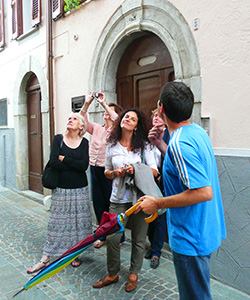
ith Michael and Nancy Morizio of Abruzzo Presto who seamlessly and expertly guide eight lucky souls to i borghi piu belli di Abruzzo. The deadline for signing up for this year’s September 20-27th tour is fast approaching. http://www.domenicacooks.com/tours/ http://www.abruzzopresto.com/
I keep promising myself that I will hunker down in a quiet (not too quiet) village to improve my Italian. Taking one or two weeks or even five days to brush up or get started on speaking Italian makes perfect sense, doesn’t it? A program in charming Agnone in Molise allows you to study hard and take a holiday at the same time. Jenifer Landor, Allesandro Aucelli and Davide Tanzj say it all in their name – Live and Learn Italian. They make it clear that they are a local, indepen
dent business whose aim is for a small number of students to integrate themselves into the fabric of the town and to experience the local customs and crafts as a welcomed friend. Sounds like paradise to me. http://www.liveandlearnitalian.com/
You can have it all on holiday in Abruzzo and Molise – personal attention, small groups, divine locations, authentic experiences and passionate guides and instructors who would be happy if you stayed a while.
-
The Legacy of AMHS Member Joe Grano
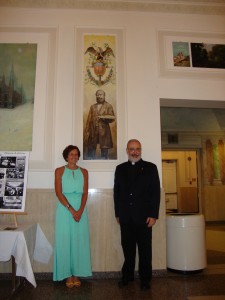
Constantino Brumidi painting in memory of Joe Grano On Saturday, June 20, 2015, around 40 people gathered at Casa Italiana for the unveiling of the painting of Constantino Brumidi, in memory of Joe Grano. Joe was a member and an officer of AMHS until his death on November 24, 2013. As President of the Society, I was quite honored that Father Marchetto asked me to unveil the painting, which was done by Raffaele De Gregorio.
Joe was a larger than life figure, involved in various causes which he took on with passion and
dedication – historic preservation of sites within
the Washington community and, of course,
securing the legacy of Constantino Brumidi. Joe founded the Constantino Brumidi Society about 15 years ago. This group became Joe’s vehicle for getting Congress to award a Congressional Gold Medal posthumously to Brumidi, the Italian immigrant whose frescos decorate the U.S. Capitol. One of Joe’s kindest acts for AMHS members was to set up a private tour of the Capitol and Brumidi’s frescos; this was about 4 years ago. We even met with the artist entrusted with restoration of the frescos.On January 19, 2014, a magnificent gathering of Joe’s friends came together in Casa Italiana, to remember an extraordinary man and to celebrate his life. Many individuals who attended that event were present for the unveiling (Bill Brown, President of the Association of Oldest Inhabi

tants of DC; Bill Rice; Nelson Rymensnyder, and Jan Fenty (mother of former DC mayor Adrian Fenty). It was good to see everyone gathered together in the celebration of Joe and his legacy. Special thanks to AMHS members who came to the event: David Ciummo, Nancy DeSanti, Dick DiBuono, Francesco and Anna Isgro, Joe Lupo, Maria Marigliano, Albert Paolantonio, Sarah Scott, Carmela Ventresca, and Sam Yothers.
Joe, you are gone but certainly not forgotten. “No longer in our lives to share, but in our hearts you are always there.”
